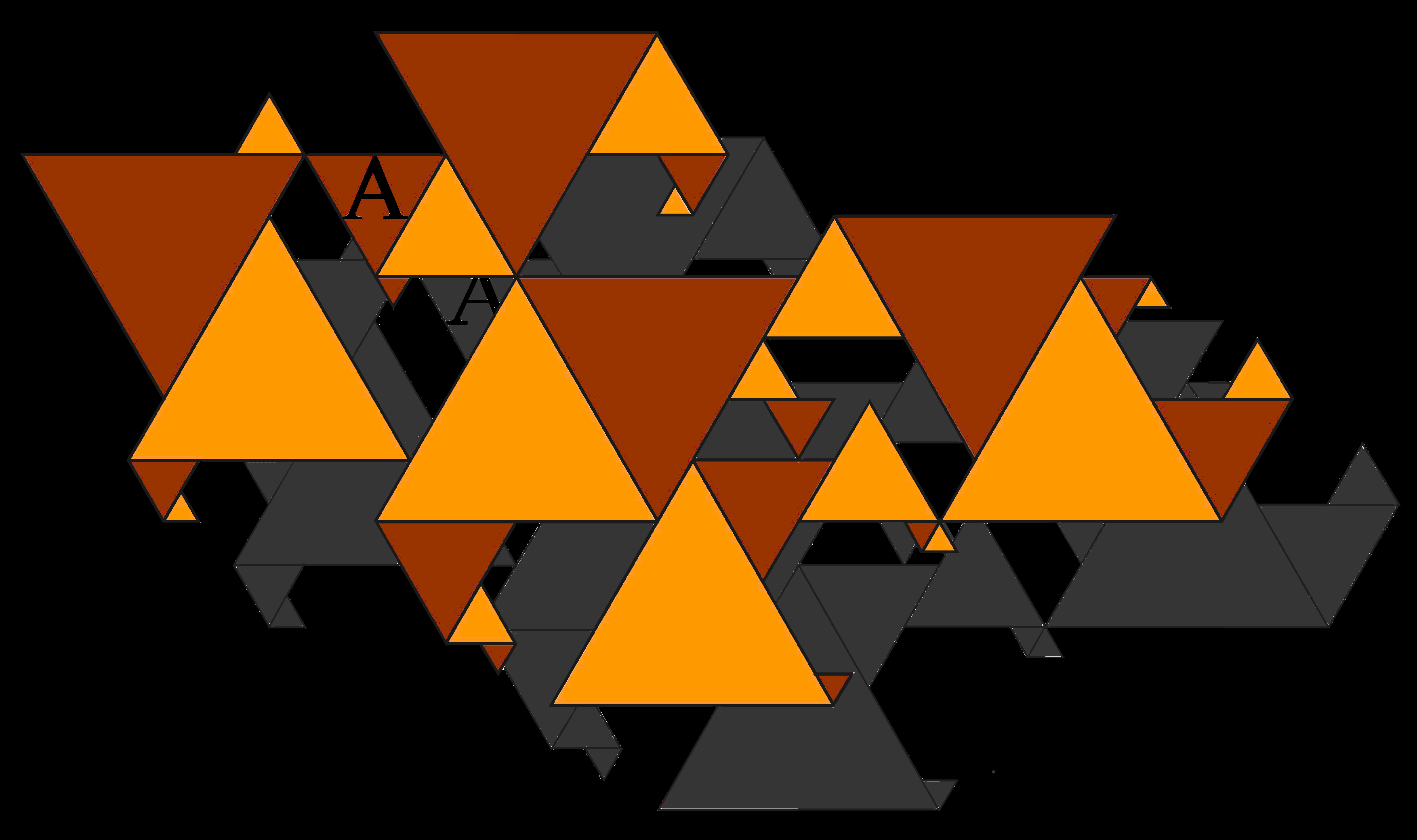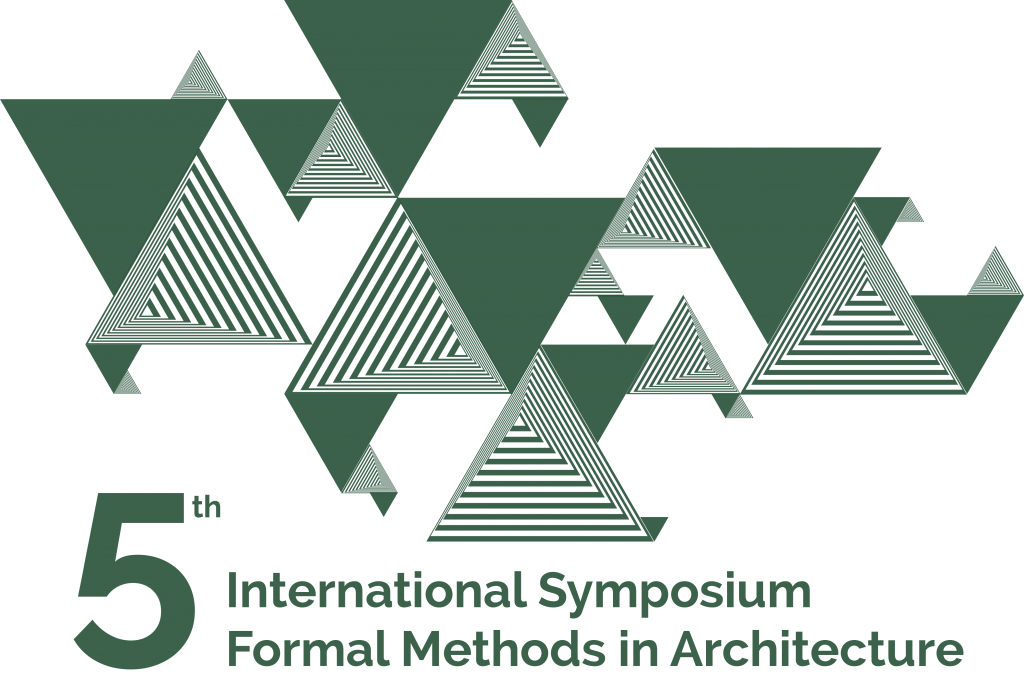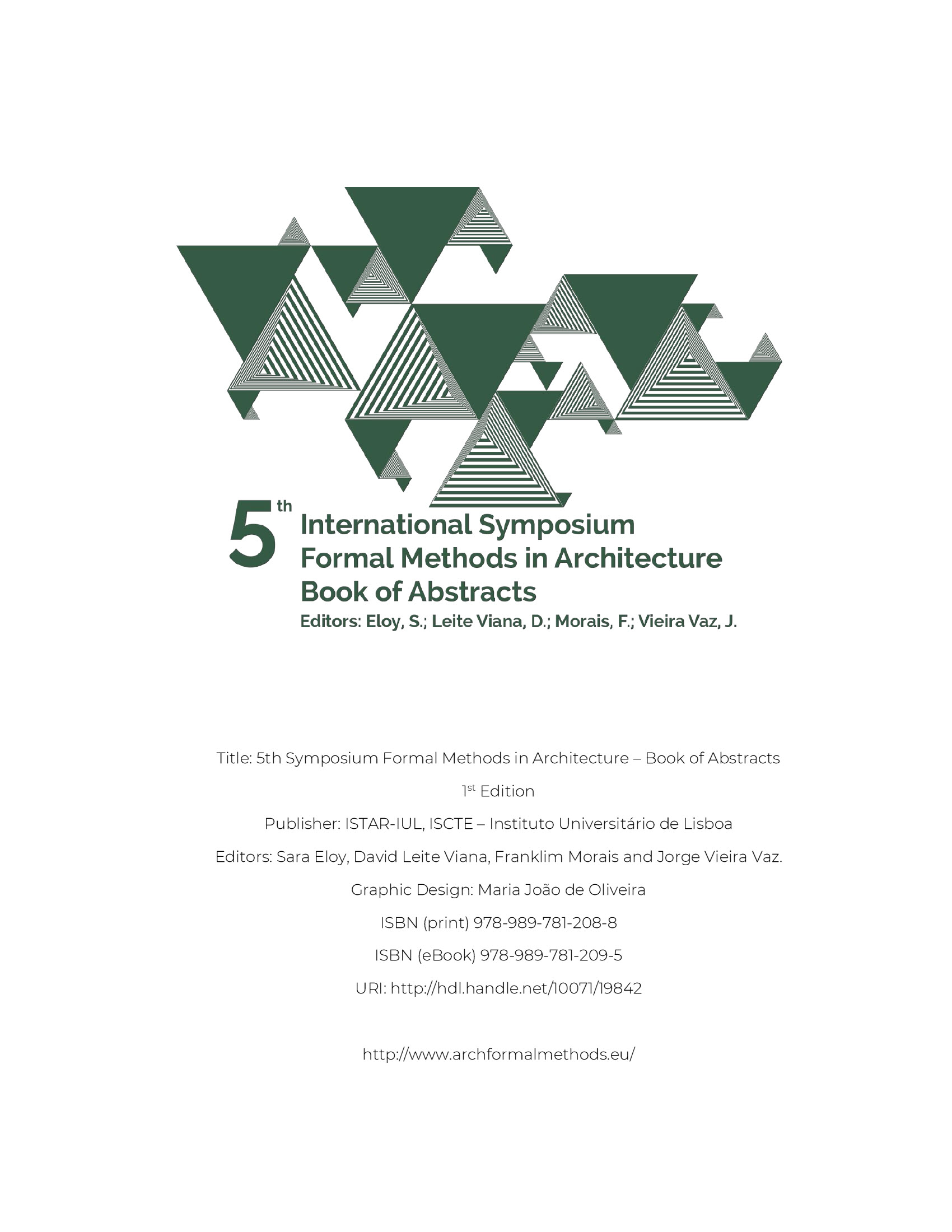
FMA SYMPOSIA series (2011-2026)
Formal Methods in Architecture

FMA SYMPOSIA series (2011-2026)
Formal Methods in Architecture
5th Symposium
LISBON 2020
2020-10-15 / 2020-10-16

The 5th Symposium "Formal Methods in Architecture" was a joint orgenization between the following departments of ESAP / Escola Superior Artística do Porto (Arts University School of Oporto):
and ISTAR - Information Sciences, Technologies and Architecture Research Center from ISCTE-IUL - Instituto Universitário de Lisboa
David Leite Viana
Information Sciences, Technologies and Architecture Research Centre, ISCTE-University Institute of Lisbon
Franklim Morais
Research Laboratory in Architecture and Design, Porto Arts Higher School
Jorge Vieira Vaz
Research Laboratory in Architecture and Design, Porto Arts Higher School
Sara Eloy
Information Sciences, Technologies and Architecture Research Centre, ISCTE-University Institute of Lisbon
Canan Albayrak Colaço
Information Sciences, Technologies and Architecture Research Centre, ISCTE-University Institute of Lisbon
Catarina Ruivo
Research Centre for Architecture, Urbanism and Design, Lisbon School of Architecture, University of Lisbon
Joana Alves
Information Sciences, Technologies and Architecture Research Centre, ISCTE-University Institute of Lisbon
Maria João de Oliveira
Dinamia'cet-IUL, ISCTE University Institute of Lisbon
Andrew I-kang Li
Kyoto Institute of Technology
Anetta Kepczynska-Walczak
Lodz University of Technology
Anette Kreutzberg
The Royal Danish Academy of Fine Arts, School of Architecture
Antonio Fioravanti
Sapienza University of Rome
António Menezes Leitão
Técnico, University of Lisbon
Armando Trento
BIMTEGRA SRL
Bob Martens
TU Wien
Canan Albayrak Colaço
Information Sciences, Technologies and Architecture Research Centre, ISCTE-University Institute of Lisbon
Catarina Ruivo
Research Centre for Architecture, Urbanism and Design, Lisbon School of Architecture, University of Lisbon
Eva Castro
Singapore University of Technology and Design
Gonçalo Castro Henriques
Laboratory of 3d Models and Digital Fabrication, Federal University of Rio de Janeiro
Gulen Cagdas
Istanbul Technical University
Henri Achten
Czech Technical University in Prague
Ioanna Symeonidou
Department of Architecture, University of Thessaly
Isabel Cristina Carvalho
Arts and Communication Research Centre, Algarve University
Joachim Kieferle
RheinMain University of Applied Sciences
João Rocha
Architecture Department, University of Évora
Joaquim Flores
Research Laboratory in Architecture and Design, Porto Higher Art School
Jorge Gil
Chalmers University of Technology
José Nuno Beirão
Lisbon School of Architecture, University of Lisbon
José Pedro Sousa
Faculty of Architecture, University of Porto
José Pinto Duarte
The Pennsylvania State University
Leandro Madrazo
School of Architecture La Salle, Ramon Llull University
Marcel Tramontano
São Paulo University
Maria Ângela Dias
PROARQ, Rio de Janeiro Federal University
Maria João de Oliveira
Dinamia'cet-IUL, ISCTE University Institute of Lisbon
Maurício Breternitz
Information Sciences, Technologies and Architecture Research Centre, ISCTE-University Institute of Lisbon
Michele Cannatá
Research Laboratory in Architecture and Design, Porto Higher Art School
Nancy Diniz
Central Saint Martins, University of the Arts London
Nuno Montenegro
Research Centre for Architecture, Urbanism and Design, Lisbon School of Architecture, University of Lisbon
Pablo C. Herrera
Peruvian University of Applied Sciences
Paolo Marcolin
Research Laboratory in Architecture and Design, Porto Higher Art School
Pieter Pauwels
Eindhoven University of Technology
Ricardo Pontes Resende
Information Sciences, Technologies and Architecture Research Centre, ISCTE-University Institute of Lisbon
Rosalia Guerreiro
CRIA, ISCTE University Institute of Lisbon
Sema Alaçan
Istanbul Technical University
Sérgio Mendes
Research Laboratory in Architecture and Design, Porto Higher Art School
Vasco Rato
Information Sciences, Technologies and Architecture Research Centre, ISCTE-University Institute of Lisbon
Vítor Oliveira
Faculty of Engineering, University of Porto
José Pinto Duarte
The Pennsylvania State University
María Lopez Calleja
MVRVD
Ramzi Hassan
Norwegian University of Life Sciences
Reinhard Goethert
Massachussets Institute of Technology
Tasos Varoudis
Space Syntax Laboratory, Bartlett School of the Built Environment, University College London
Canan Albayrak Colaço
Information Sciences, Technologies and Architecture Research Centre, ISCTE-University Institute of Lisbon
Catarina Ruivo
Research Centre for Architecture, Urbanism and Design, Lisbon School of Architecture, University of Lisbon
Franklim Morais
Porto Arts Higher School
Joana Alves
Information Sciences, Technologies and Architecture Research Centre, ISCTE-University Institute of Lisbon
Jorge Vieira Vaz
Research Laboratory in Architecture and Design, Porto Higher Art School
Maria João de Oliveira
Dinamia'cet-IUL, ISCTE University Institute of Lisbon
Ricardo Pontes Resende
Information Sciences, Technologies and Architecture Research Centre, ISCTE-University Institute of Lisbon
Rosalia Guerreiro
CRIA, ISCTE University Institute of Lisbon

Publisher: ISTAR‐IUL, ISCTE – Instituto Universitário de Lisboa
isbn: 978-989-781-208-8
Pages: 36
Editors:
David Leite Viana
Information Sciences, Technologies and Architecture Research Centre, ISCTE-University Institute of Lisbon
Franklim Morais
Porto Arts Higher School
Jorge Vieira Vaz
Research Laboratory in Architecture and Design, Porto Higher Art School
Sara Eloy
Information Sciences, Technologies and Architecture Research Centre, ISCTE-University Institute of Lisbon
| Page | Title | Authors |
|---|---|---|
| 10 | L´Objet Invalide | Aniruddha Mukherjee |
| 11 | Agent-based Semiology: Optimizing Office Occupation Patterns With Agent-based Simulations | Robert Neumayr |
| 12 | Digital Doxiadis: Parametric Thinking for Human Settlements | Alexandros Peteinarelis Nikolas Patsavos |
| 13 | Tectonics of differential growth. Folds in additive fabrication and moulding for architectural design. | Daniel Svitak Imrich Vaško Petra Sochurkova Shota Tsikoliya |
| 14 | Design to Experiment, Experiment to Design: Tool-user,Tool-breaker,Tool-designer | Ekin Ünlü Sema Alaçan |
| 15 | What about if buildings respond to my mood? | Ana Almeida Luísa Almeida Sara Eloy |
| 16 | Upgrading Participation through Computational Thinking in Architecture | Canan Albayrak Colaço Zeynep Mennan |
| 17 | Borealis sound an Interactive wall: users’ response to responsive architecture | Beatriz Couto Sara Eloy |
| 18 | Tools for the co-designing of housing transformations: a study on interaction and visualization modes | Fábio Costa Micaela Raposo Pieter E. Vermaas Sara Eloy |
| 19 | Building Circulation from a Syntactic Context in Relation to Indoor Thermal Environment | Leen Hiasat Pedro Januário |
| 20 | Nature Pleated Surfaces | Filipa Crespo Osório Maria João de Oliveira |
| 21 | Multi-scale configurational approach to the design of public open spaces after urban disasters | Camilla Pezzica Chiara Chioni Clarice Bleil de Souza Simone Rusci Valerio Cutini |
| 22 | Space, Adaptability and Use: Triangulating research criteria for adaptability retrieval | Carolina Coelho |
| 23 | Data Driven Spatial Analysis of Urban Renewal. Network Kernel Density Estimation of Building Renovation | Filipe Brandão Ricardo Mendes Correia Rosalia Guerreiro |
| 24 | Public Space Use: an Approach to Livability in Urmia Bazaar, Iran | Francisco Serdoura Momen Foadmarashi |
| 25 | Non-intrusive semi-automated modelling of ordinary buildings’ intermediate floors: Collective housing in Porto, Portugal | David Pereira-Martínez Gisela Lameira Isabel Raposo Plácido Lizancos Virgílio Borges Pereira |
| 26 | Adapting Analysis Workflows to Hamanitarian Needs: Different Road Network Models and Tools | Alessandro Santucci Camilla Pezzica Clarice Bleil de Souza Valerio Cutini |
| 27 | Urban forms of informality: decoloniality as a perspective for morphological studies | Silvia Spolaor Vítor Oliveira |
| 28 | Understanding a bastion castle in Pidhirtsi using the Space Patterns system for spatial analysis | Olha Tikhonova |
| 29 | Reconstructing photogrammetric 3D model by using deep learning | Chi-Li Cheng June-Hao Hou |
| 30 | Topologic: Exploring spatial reasoning through geometry, topology, and semantics | Aikaterini Chatzivasileiadi Wassim Jabi |
| 31 | Collaboration of Visual Intelligence between Human and Machinic Actors in Design Processes | Egemen Berker Kizilcan |
| 32 | LBD server: Visualising Building Ontologies in web-based environments using glTF-models | Andrew Malcolm Jeroen Werbrouck Pieter Pauwels |
| 33 | SCAVATools, strategies and tools for the mass dissemination of SCAVA techniques | Catarina Ruivo David Leite Viana Franklim Morais Isabel Cristina Carvalho Jorge Vieira Vaz |
| 34 | Spectral Clustering and Integration - The inner dynamics of computational geometry and spatial morphology | Alan Penn Tasos Varoudis |
| 35 | Self-learning Agents for Spatial Synthesis | Pedro Veloso Ramesh Krishnamurti |
| 6 | Variational Beauty of Space. Machine Intuition and Urban Networks | Tasos Varoudis |
| 6 | Compact City–Urban Sprawl – Sites & Services Challenges in the COVID-19 Era | Reinhard Goethert |
| 6 | From Datascape to Formal Methods | María Lopez Calleja |
| 6 | speech from Ramzi Hassan | Ramzi Hassan |
| 6 | The Ethics of our Work | José Pinto Duarte |
| 8 | Mathematically developing building facades: an algorithmic framework | António Menezes Leitão Inês Caetano |
| 9 | BIM based Airport Project Standardization (IFC) for use of Code Checking | Adriana Carvalho Ítalo Guedes Max Andrade |

Publisher: Springer Nature Switzerland
ISBN: 978-3-030-57508-3
Pages: 313
Editors:
David Leite Viana
Information Sciences, Technologies and Architecture Research Centre, ISCTE-University Institute of Lisbon
Franklim Morais
Porto Arts Higher School
Jorge Vieira Vaz
Research Laboratory in Architecture and Design, Porto Higher Art School
Sara Eloy
Information Sciences, Technologies and Architecture Research Centre, ISCTE-University Institute of Lisbon
| Page | Title | Authors |
|---|---|---|
| 101 | Nature Pleated Surfaces | Filipa Crespo Osório Maria João de Oliveira |
| 115 | Building Circulation from a Syntactic Context in Relation to Indoor Thermal Environment | Leen Hiasat Pedro Januário |
| 123 | What about if buildings respond to my mood? | Ana Almeida Luísa Almeida Sara Eloy |
| 133 | Borealis sound an Interactive wall: users’ response to responsive architecture | Beatriz Couto Sara Eloy |
| 147 | Space, Adaptability and Use: Triangulating research criteria for adaptability retrieval | Carolina Coelho |
| 157 | Adapting Analysis Workflows to Hamanitarian Needs: Different Road Network Models and Tools | Alessandro Santucci Camilla Pezzica Clarice Bleil de Souza Valerio Cutini |
| 171 | Multi-scale configurational approach to the design of public open spaces after urban disasters | Camilla Pezzica Chiara Chioni Clarice Bleil de Souza Simone Rusci Valerio Cutini |
| 185 | Data Driven Spatial Analysis of Urban Renewal. Network Kernel Density Estimation of Building Renovation | Filipe Brandão Ricardo Mendes Correia Rosalia Guerreiro |
| 19 | Design to Experiment, Experiment to Design: Tool-user,Tool-breaker,Tool-designer | Ekin Ünlü Sema Alaçan |
| 197 | Urban forms of informality: decoloniality as a perspective for morphological studies | Silvia Spolaor Vítor Oliveira |
| 207 | Non-intrusive semi-automated modelling of ordinary buildings’ intermediate floors: Collective housing in Porto, Portugal | David Pereira-Martínez Gisela Lameira Isabel Raposo Plácido Lizancos Virgílio Borges Pereira |
| 221 | Understanding a bastion castle in Pidhirtsi using the Space Patterns system for spatial analysis | Olha Tikhonova |
| 231 | Public Space Use: an Approach to Livability in Urmia Bazaar, Iran | Francisco Serdoura Momen Foadmarashi |
| 243 | Spectral Clustering and Integration - The inner dynamics of computational geometry and spatial morphology | Alan Penn Tasos Varoudis |
| 251 | SCAVATools, strategies and tools for the mass dissemination of SCAVA techniques | Catarina Ruivo David Leite Viana Franklim Morais Isabel Cristina Carvalho Jorge Vieira Vaz |
| 265 | Self-learning Agents for Spatial Synthesis | Pedro Veloso Ramesh Krishnamurti |
| 277 | Topologic: Exploring spatial reasoning through geometry, topology, and semantics | Aikaterini Chatzivasileiadi Wassim Jabi |
| 287 | LBD server: Visualising Building Ontologies in web-based environments using glTF-models | Andrew Malcolm Jeroen Werbrouck Pieter Pauwels |
| 29 | Tectonics of differential growth. Folds in additive fabrication and moulding for architectural design. | Daniel Svitak Imrich Vaško Petra Sochurkova Shota Tsikoliya |
| 295 | Reconstructing photogrammetric 3D model by using deep learning | Chi-Li Cheng June-Hao Hou |
| 3 | Mathematically developing building facades: an algorithmic framework | António Menezes Leitão Inês Caetano |
| 305 | Collaboration of Visual Intelligence between Human and Machinic Actors in Design Processes | Egemen Berker Kizilcan |
| 37 | BIM based Airport Project Standardization (IFC) for use of Code Checking | Adriana Carvalho Ítalo Guedes Max Andrade |
| 49 | Agent-based Semiology: Optimizing Office Occupation Patterns With Agent-based Simulations | Robert Neumayr |
| 61 | Digital Doxiadis: Parametric Thinking for Human Settlements | Alexandros Peteinarelis Nikolas Patsavos |
| 75 | L´Objet Invalide | Aniruddha Mukherjee |
| 85 | Upgrading Participation through Computational Thinking in Architecture | Canan Albayrak Colaço Zeynep Mennan |
| 91 | Tools for the co-designing of housing transformations: a study on interaction and visualization modes | Fábio Costa Micaela Raposo Pieter E. Vermaas Sara Eloy |
| v | Formal Methods in Architectura: Preface | David Leite Viana Franklim Morais Jorge Vieira Vaz Sara Eloy |
| xi | The Ethics of our Work | José Pinto Duarte |
| xii | Variational Beauty of Space. Machine Intuition and Urban Networks | Tasos Varoudis |
| xii | From Datascape to Formal Methods | María Lopez Calleja |
| xv | Global and Disciplinary Frameworks for Formal Methods in Architecture | David Leite Viana Franklim Morais Jorge Vieira Vaz |